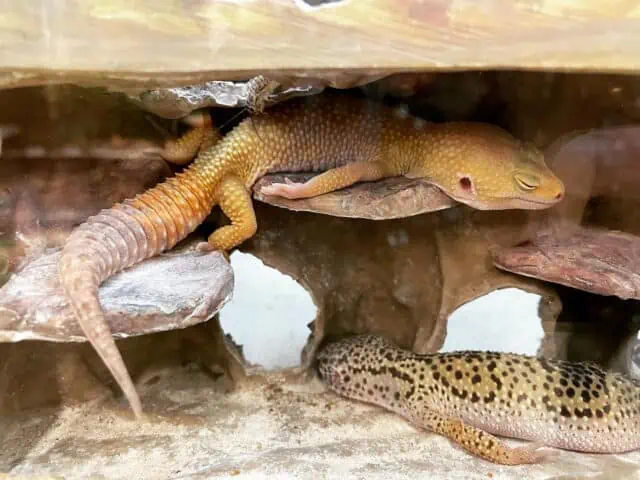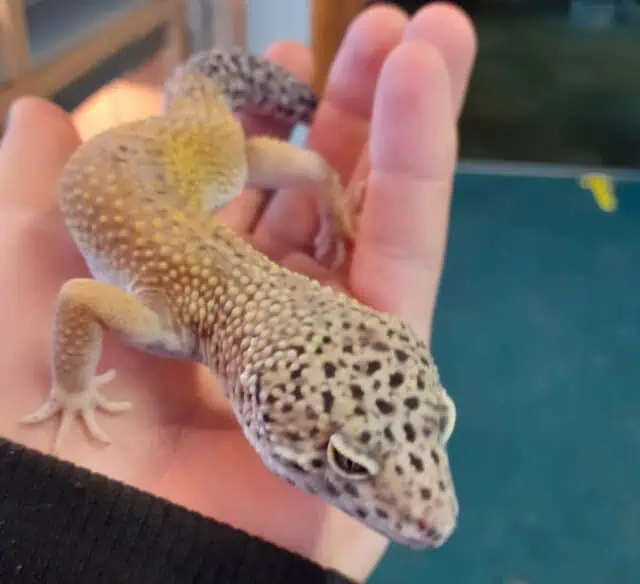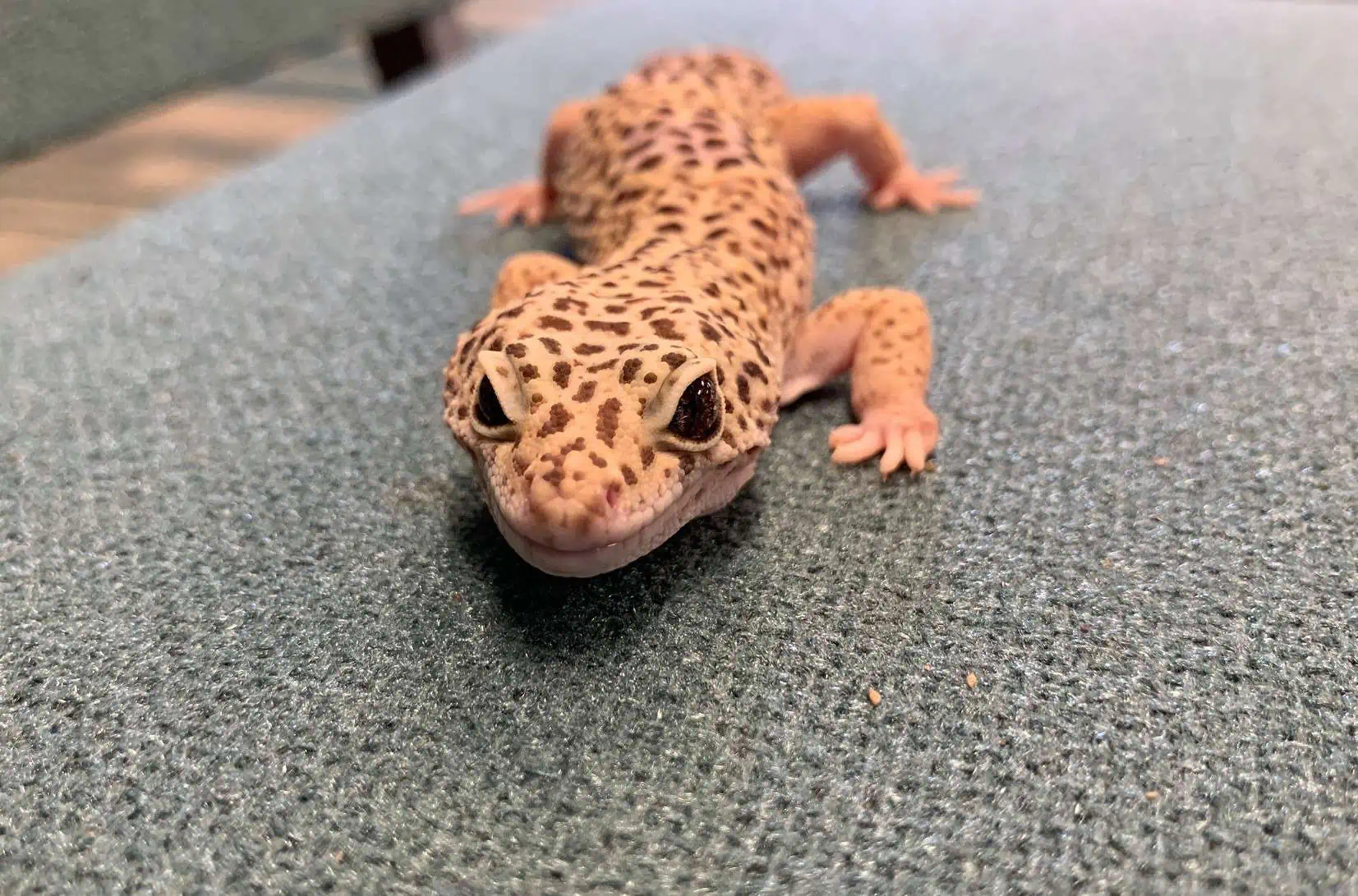Do leopard geckos get lonely? The short answer is no, leopard geckos are naturally solitary animals and do not get lonely. They thrive when living alone, exhibiting their full range of natural behaviors and maintaining optimum levels of alertness.
Originating from the harsh, isolated terrains of Asia and the Middle East, leopard geckos have evolved to be self-reliant and are not sociable creatures by nature, except during the mating season. They lack a social structure and don’t seek companionship from other geckos or form groups or colonies in the wild.
Solitary by Nature: Leopard geckos are naturally solitary creatures, typically only seeking social interaction during mating seasons.
Compatibility Concerns: Male leopard geckos can live with several females during mating but shouldn’t be housed with other males due to territorial disputes. Adult geckos also have potential risks when housed with younger ones.
Human Interaction: While leopard geckos are generally shy towards humans, with proper care and consistent bonding, they can develop a level of trust and may even recognize their owners.
Housing Females Together: Two female leopard geckos have a higher chance of cohabitating successfully. However, it’s crucial to provide a spacious enclosure with multiple hiding spots and separate feeding areas.
Monitor for Signs of Stress: Keeping an eye out for signs of aggression or stress is essential, especially when attempting to house geckos together. Adjustments might be needed to ensure their well-being.
Do Leopard Geckos Get Lonely?
Leopard geckos are not prone to feelings of loneliness as they are inherently solitary creatures. They have evolved to thrive in isolation, preferring the company of their own selves over interaction with other geckos. The inherent solitary nature of these fascinating reptiles makes them well-suited to a life of independence, devoid of the social bonds seen in many other species.
The Nature of Leopard Geckos – Why They Do Better Alone
Leopard geckos, known scientifically as Eublepharis macularius, are distinct for their solitary lifestyles, showcasing natural behaviors that are best observed when they are alone. In the wild, these solitary creatures are primarily nocturnal, staying alert to the threats and activities in their environment, avoiding predators and seeking prey.
In the vast, arid landscapes they inhabit, social interaction is nearly nonexistent, except during the brief mating seasons. They don’t form colonies or social structures, and every leopard gecko largely fends for itself. The absence of a need for companionship underscores their solitary nature, allowing them to live and thrive without the support or presence of others of their kind.
This lack of interaction, rather than being detrimental, is crucial for the leopard gecko, ensuring they stay true to their natural behaviors and instincts.
Their solitary lifestyle enables them to be more attuned to their surroundings, responding quickly to potential threats and efficiently managing their resources without competition or interference from other geckos.
Their life in isolation also emphasizes their self-reliance, as they hunt, explore, and rest without the need for cooperation or coexistence with other leopard geckos. These fascinating behaviors and adaptations make it evident that leopard geckos not only prefer to be alone but also flourish in solitude.
Do Leopard Geckos Do Better in Pairs or Alone?

When considering whether leopard geckos do better in pairs or alone, their solitary nature and territorial behavior play pivotal roles. They are inherently designed to thrive in solitude, their lifestyles woven around their individual needs and preferences, far removed from the complexities of social structures and bonds.
Male leopard geckos showcase a clear preference for solitude, with a notable exception during the mating season when they can coexist with several females. However, outside of this period, it is crucial that they are kept alone to prevent territorial disputes and ensure their well-being.
Territorial behavior and signs of aggression are prominent when leopard geckos are forced into cohabitation. Signs such as biting, tail-raising, and loud vocalizations indicate stress and discomfort, signaling the need for immediate separation to prevent harm and distress.
Can I Put a Male and Female Leopard Gecko Together?
Introducing a male and female leopard gecko to each other involves understanding and respecting their unique breeding conditions and behaviors.
Typically, male and female leopard geckos are placed together under controlled conditions for mating and breeding purposes. While this temporary coexistence is vital for propagation, it’s crucial to be mindful of the inherent challenges and stresses it can bring to the animals.
Male leopard geckos exhibit aggressive behaviors during mating, such as biting, which is a natural part of their mating ritual but can cause stress and harm to both animals.
The intensity of this aggression underscores the need for careful monitoring and immediate separation once mating has occurred to prevent any post-mating altercations and ensure the well-being of both geckos.
Can I Put Two Male Leopard Geckos Together?
Considering housing two male leopard geckos together necessitates a thorough understanding of their natural behaviors and tendencies, as it can lead to several challenges.
Male leopard geckos are particularly territorial, and placing them in the same enclosure can result in serious disputes and aggressive behaviors. These interactions are marked by biting, loud vocalizations, and other signs of distress, indicating an urgent need for separation to avoid harm.
Several factors must be meticulously considered when contemplating housing two males together. One such factor is the size difference between the geckos; discrepancies in size can significantly impact their interactions, often leading to the larger gecko bullying the smaller one, causing undue stress and potentially injuries.
Can I Put an Adult Leopard Gecko with a Young One?
Considering the compatibility between an adult leopard gecko and a younger one involves delving into the intricacies of their individual needs and behavioral tendencies. Generally, housing an adult with a young gecko is not recommended due to the inherent risks and significant considerations involved.
The adult, being larger and more dominant, may exhibit aggression towards the younger, smaller gecko, posing a substantial risk of injury and stress to both animals.
The potential risks of combining adult and young leopard geckos revolve primarily around the disparities in size and strength, making the environment unsafe and stressful. Aggressive behaviors, competition for resources, and the potential for the larger adult to injure the smaller young one are constant concerns when they share an enclosure.
Providing separate enclosures is crucial to circumvent these risks and ensure the well-being of both the adult and the young leopard gecko.
Can Two Female Leopard Geckos Live Together?
When discussing the compatibility of female leopard geckos, it’s essential to understand that while these creatures are primarily solitary, two females are likelier to cohabitate successfully. However, ensuring their peaceful coexistence requires adherence to several guidelines and continuous observation of their behavior.
Female leopard geckos, when housed together, need a spacious enclosure to prevent territorial disputes and aggression. The enclosure should be equipped with multiple hiding spots, allowing each gecko a place to retreat and feel secure.
Separate feeding areas are also crucial to avoid competition and ensure that both geckos have access to the necessary nutrients. Additionally, maintaining proper temperature gradients within the enclosure is essential for their comfort and well-being.
Even with the optimal conditions provided, it is imperative to closely monitor the geckos for any signs of aggression or territorial disputes. Observing their interaction and intervening promptly when disputes arise is crucial to maintaining a harmonious environment.
Do Leopard Geckos Enjoy Having Humans Around?

Leopard geckos, inherently solitary and devoid of complex social structures, have unique perceptions and reactions to human interaction. Generally, these geckos are not aggressive towards humans; instead, they display a natural shyness and a preference for solitude, interacting only when they feel secure and safe.
Their solitary nature does not, however, mean they cannot form bonds with their human caregivers. With consistent, gentle, and respectful interaction, leopard geckos can be socialized to develop a level of trust and recognition with their owners.
They may start to associate their caregivers with food and safety, leading to more relaxed and willing interactions over time.
While it’s not to say that leopard geckos “enjoy” the company of humans in the way that more socially oriented pets might, they can certainly become accustomed to and comfortable with human presence.
Observing behaviors such as glass surfing or changes in sleeping patterns can provide insights into their comfort levels and well-being in relation to human interaction, helping owners understand and cater to their individual needs and preferences.






